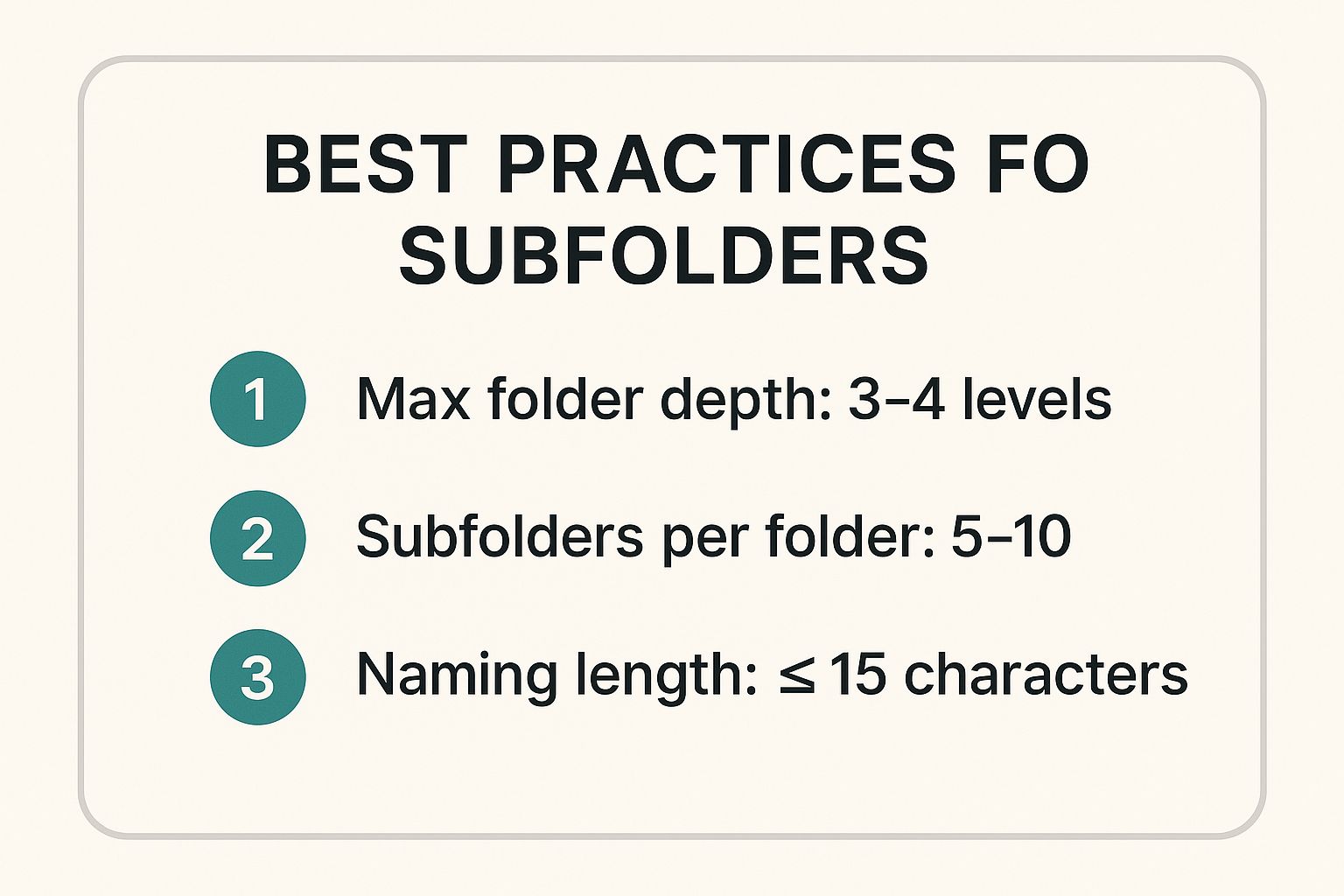Think about how you organize files on your computer. You don't just dump everything onto your desktop, right? You create folders for "Work," "Photos," and "Projects" to keep things tidy. A subfolder on a website works exactly the same way.
It’s simply a folder that lives inside your main website domain. If your website is yourwebsite.com, a subfolder would look like yourwebsite.com/blog or yourwebsite.com/services. This structure keeps all your content neatly organized under one main "roof"—your primary domain.
What Is a Subfolder in Simple Terms

Let's stick with the filing cabinet analogy. Imagine your entire website is a big digital filing cabinet. Without any labels or drawers, finding a specific document would be a nightmare. A subfolder, which you'll also hear called a subdirectory, acts as one of those labeled drawers.
It sits right after your main domain name in the URL, helping you group related content together. This isn't just a nerdy technical detail; it's the bedrock of a well-organized, user-friendly website. By creating logical sections like /about-us, /products, or /contact, you lay out a clear, predictable path for anyone visiting your site.
The Anatomy of a Subfolder
At its core, a subfolder is just a folder that sits inside another folder on your website's server. For example, with the URL www.example.com/blog/, the blog part is the subfolder. It's living inside the main domain's "folder."
This creates a simple hierarchy that both people and search engines can easily understand. You can learn more about the technical side and its SEO impact from this in-depth glossary entry on subfolders.
Key Takeaway: The whole point of a subfolder is to bring order to your content. It builds a logical structure that makes your website far easier to navigate and understand.
To break this down even further, here's a quick reference table.
Subfolder Characteristics at a Glance
| Attribute | Description |
|---|---|
| Structure | A folder within the root domain (e.g., domain.com/folder). |
| Use Cases | Organizing content by category, like a blog, product section, or help center. |
| Primary Benefit | Consolidates all content under a single domain, simplifying navigation and SEO. |
This simple organizational choice has some pretty significant ripple effects. A clean subfolder structure tells visitors your site is professional and thoughtfully designed. More importantly, it helps search engines like Google crawl and index your pages much more efficiently, which is a critical first step toward earning better rankings. We'll dig into all of those benefits as we go.
Absolutely. Here is the rewritten section with a more natural, human-expert tone.
How Subfolders Create an Intuitive Website Experience
So, we know what a subfolder is, but why does it actually matter? Think of it this way: your website is like a physical building. Without a good subfolder structure, you’re essentially throwing all your content into one giant room and hoping people can find what they’re looking for. It’s pure chaos.
Subfolders are the hallways and labeled doors that guide people through that building. They create a clear, intuitive map. A well-organized site doesn't make users think; it just works, effortlessly guiding them to the content they need and preventing the kind of frustration that sends them clicking the back button.
Picture walking into a huge department store with no signs. You're looking for running shoes, but you have no idea where to even start. It's a frustrating, time-wasting experience. Now, imagine a URL like mystore.com/shoes/running/. It’s like a clear sign hanging from the ceiling: "Shoes" -> "Running Shoes." A user instantly knows where they are and can easily guess how to find a related category, like /shoes/hiking/.
Building Trust Through Structure
This logical flow does more than just help people find their way around; it quietly builds trust. A clean, organized URL is a subtle signal that your site is professional and designed with the user in mind. Visitors feel more confident that they can explore other sections without getting hopelessly lost.
A food blog is a perfect example of this in action. A URL like /recipes/desserts/chocolate-cake is infinitely more helpful and predictable than a jumble of pages with no clear hierarchy. That predictability is what encourages a visitor to stick around and see what other dessert recipes you have.
A thoughtful subfolder structure is one of the most effective ways to improve user experience. It creates a seamless journey that keeps people on your site longer—and that’s a huge positive signal for modern search engines.
Ultimately, good site architecture shapes how people feel about your website. It’s the difference between walking into a cluttered, confusing mess and a well-designed, helpful space.
Here’s how this works for different kinds of websites:
- A Corporate Site: Using paths like
/services/marketing/and/services/consulting/keeps your business offerings distinct and easy to understand. - A News Site: Organizing content with
/news/world/and/news/local/lets readers quickly zero in on the stories that matter most to them. - A Support Portal: A structure like
/help/billing/invoices/guides a stressed-out customer directly to the solution they need, right when they need it.
In every case, subfolders turn a simple collection of pages into a truly structured, navigable experience. This commitment to a user-first design is what separates a forgettable website from a successful online presence that both people and search engines love.
The Power of Subfolders for SEO Performance

While a clean structure is great for users, it’s an absolute game-changer for your search engine optimization (SEO). This is where the debate between using yourwebsite.com/blog (a subfolder) versus blog.yourwebsite.com (a subdomain) really matters. The secret lies in a concept called link equity.
Think of link equity as your website's reputation or "SEO juice." Every time a trustworthy site links to your pages, it passes a bit of that authority to you. When you use subfolders, all that valuable authority gets funneled into one place: your main domain. Every blog post, every product page, and every guide you publish works together to build the strength of the entire site.
This is a huge advantage over subdomains. Search engines like Google often see a subdomain as a separate entity, almost like a different website. That means any authority your blog earns on blog.yourwebsite.com might not do much to help the main yourwebsite.com rank.
Consolidating Your Ranking Authority
Keeping all your content in subfolders is like building one strong, impressive mansion instead of a main house with a few flimsy sheds out back. Every piece of content you create and every backlink you earn contributes to the authority of that single domain, making the whole structure more powerful.
From an SEO perspective, this consolidation is a significant advantage. Studies show that websites using subfolders can see improved search rankings—by as much as 20%—due to this concentrated link equity and easier content indexing by search engines. You can discover more about these SEO benefits.
This unified approach also sends a clear message to Google. It demonstrates that your entire site is a comprehensive resource on your core topics, rather than a collection of fragmented, disconnected parts.
Making Your Site Easier to Crawl
A logical subfolder structure doesn't just pool your authority; it also gives search engine crawlers a clear roadmap of your site. These bots follow links to discover and index your content, and a clean path like /services/marketing/ or /products/shoes/ helps them understand how your pages are related.
When crawlers can move through your site efficiently, your new content gets found and indexed much faster. More importantly, when Google can easily map out your site's architecture, it gets a better handle on what your content is about and who it should show it to. That clarity is exactly what you need to climb the search results and attract more organic traffic.
Subfolder vs Subdomain A Clear Comparison
So, we've covered how subfolders are great for pulling all your site's authority under one roof. Now it's time to tackle the classic debate: subfolders versus subdomains. On the surface, they might look similar, but they represent two very different ways to structure a website, and choosing the right one is a critical strategic decision.
Let's revisit our real estate analogy. If your website is your main house, a subfolder is simply a room inside that house. Think yourwebsite.com/blog or yourwebsite.com/services. It's an integral part of the primary structure.
A subdomain, on the other hand, is more like a separate guesthouse on the same piece of land. It looks something like blog.yourwebsite.com or shop.yourwebsite.com. While it's connected to your property, Google and other search engines often see it as a completely separate building.
This distinction has massive implications for your SEO. Search engines treat subfolders as part of your main site, so all the authority and "link juice" flows back to the core domain. In contrast, subdomains are frequently treated as separate websites, meaning their SEO power is often walled off and doesn't directly contribute to your main site's strength.
When to Use Each Structure
So how do you decide? It really boils down to the purpose of your content. Are you just adding a new section to your main website, or are you creating something that needs to stand on its own?
For content that's closely related to your main brand—like a blog, a knowledge base, or different product categories—a subfolder is almost always the best move. It keeps all your SEO value consolidated and gives users a seamless experience.
A subdomain really only makes sense when the content is functionally distinct from your core website. Common examples include a customer support portal, a completely separate e-commerce store with different branding, or unique versions of your site for different countries.
This image lays out some great best practices for organizing your subfolders for clarity and impact.

The key takeaway is to build a shallow, logical hierarchy that makes it easy for both users and search engines to find what they're looking for.
To make this choice even clearer, let's put them side-by-side.
Subfolder vs Subdomain Key Differences
This table breaks down the core distinctions between using a subfolder and a subdomain.
| Factor | Subfolder (e.g., example.com/blog) | Subdomain (e.g., blog.example.com) |
|---|---|---|
| URL Structure | Appears after the main domain, like a page within the site. | Appears before the main domain, signaling a separate site. |
| SEO Impact | Shares and consolidates link authority with the main domain. | Often splits link authority, as it's treated as a distinct entity. |
| Best Use Case | Core content like blogs, services pages, and product catalogs. | Functionally different sections like support portals or international sites. |
At the end of the day, for most businesses aiming to build authority and improve their search rankings, the choice is clear. Using a subfolder ensures that every article you publish and every backlink you earn works together to strengthen one powerful, unified domain.
Practical Tips for Naming Your Subfolders

Getting your subfolder structure right from the start is one of the smartest things you can do for your website. It’s a classic case of "an ounce of prevention is worth a pound of cure," saving you from massive organizational headaches later on. Think of it as building a strong foundation for both your users and your SEO.
The whole point is to create a hierarchy that just makes sense. It should be scalable for the future and, most importantly, intuitive for a first-time visitor. Put yourself in their shoes: if they were looking for something specific, what logical path would they take? Your subfolder names are the signposts that guide them.
A vague URL like yourstore.com/cat3/p45b is a dead end; it tells the user absolutely nothing. But a clear, descriptive URL like yourstore.com/womens-boots is instantly recognizable and builds confidence. That simple tweak makes your entire site easier to explore.
Core Naming Conventions
To build a clean and effective site structure, it's best to stick with a few simple, universally accepted rules. Following these best practices ensures your subfolder names work for people and search engines alike, heading off common technical glitches before they even start.
Consistency here creates a predictable, user-friendly experience.
Here are the essential rules to live by:
- Stick to lowercase letters. Always. While some web servers don't mind uppercase letters, using them can open a can of worms with duplicate content issues and broken links. Keep it simple and consistent.
- Use hyphens to separate words. If a subfolder name needs multiple words, like "running shoes," always connect them with a hyphen (-). The result,
/running-shoes, is perfectly readable for both humans and search engines. Steer clear of underscores (_) or spaces (which turn into an ugly%20).
Crucial Tip: A shallow hierarchy beats a deep, complex one almost every time. Resist the urge to create endless nested subfolders like
/category/product/type/style/item. This "buries" your content, making it a chore for both users and search engine crawlers to find. The goal should be to get people where they need to go in just a few clicks.
By putting these practical tips into action, you'll build a clean, logical site architecture that grows with you. It’s a fundamental piece of the puzzle that supports everything else you do online.
Answering Your Top Questions About Subfolders
As you start mapping out your site’s architecture, you’re bound to hit a few specific hurdles. Getting the practical side of subfolders right can be the difference between a smooth launch and a technical headache. Let's tackle some of the most common questions that pop up.
Think of this as your quick-reference guide for the real-world challenges of putting a subfolder strategy into action. Each answer is designed to give you clarity and confidence.
Can I Move My Blog from a Subdomain to a Subfolder?
Absolutely. In fact, it’s one of the smartest SEO moves you can make. Shifting your content from blog.yourwebsite.com to yourwebsite.com/blog is a fantastic way to consolidate your site's authority. All the SEO juice your blog has accumulated over the years suddenly starts boosting your main domain directly.
The trick is in the execution. This process lives or dies by your redirect strategy. You must set up 301 redirects for every single old blog URL, pointing them to their new home in the subfolder. This is how you tell search engines, "Hey, this content has moved permanently," ensuring you transfer all that valuable link equity and avoid a mess of broken links.
How Many Subfolders Are Too Many?
There isn't a magic number here. The real goal is keeping your site structure logical and shallow, not sticking to an arbitrary limit. Instead of counting folders, put yourself in your user's shoes.
The question you should always be asking is: Can someone find what they're looking for within two or three clicks from the homepage? A flat, intuitive structure will always win against a deep, confusing one.
What you really want to avoid are deeply nested rabbit holes like /services/marketing/seo/local/analytics. Paths like that can bury your content so deep that neither users nor search engine crawlers can easily find it.
Do Subfolders Make a Website Slower?
Nope, not at all. Subfolders have virtually no impact on your site's loading speed. A subfolder is just a way to organize files on a server—it’s like putting documents into different manila folders in a filing cabinet. It doesn't add any extra technical weight or processing demands.
Your site’s performance comes down to other things entirely, like the quality of your web hosting, how large your image files are, and whether your code is clean and optimized. The subfolder vs. subdomain debate is a strategic one about SEO and user experience, not site speed.
Curious how AI models see your website's structure? Llamo Pro can reveal gaps in your brand's online visibility in under a minute. See your site through the eyes of AI and discover opportunities for better optimization. Learn more at https://llamo.pro.

